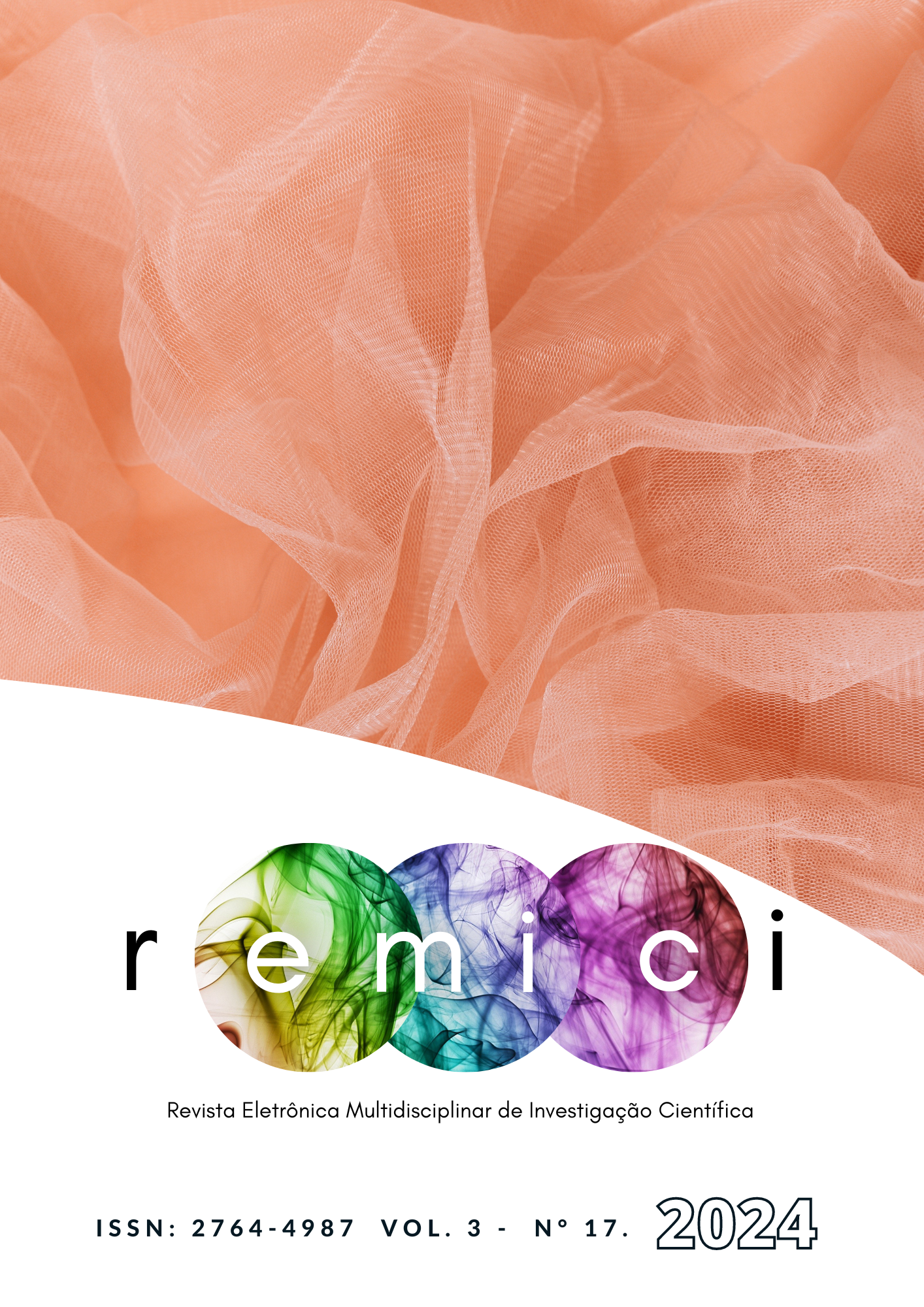EMERGÊNCIA E MORFOLOGIA DE SEMENTES DE PLÂNTULAS DE MAMOEIRO SOB DIFERENTES CONDIÇÕES DE SUBSTRATO E DE ARMAZENAMENTO
Main Article Content
Abstract
This work aims to analyze the influence of different storage environments and substrates on the emergence of papaya seedlings. The work was carried out in the municipal nursery of the municipality of Capanema, in partnership with the Federal Rural University of the Amazon, located in the aforementioned educational institution. To carry out the study, papaya fruits of the Hawaii cultivar were collected, in a commercial cultivation on an agricultural property located in the KM 2 community of Pará-Maranhão, a rural area in the municipality of Capanema, located in the Caetés microregion, in the Northeast of Pará, with geographic coordinates of 01° 11' 45” S, 47° 10' 51” W. The experimental design was completely randomized where two experiments were carried out: the first experiment was three types of substrates: Sawdust (T1), sawdust + washed sand (T2) and pure washed sand (T3). Each evaluated substrate consisted of three replications of 20 papaya seeds each and the variables analyzed were: percentage of seedling emergence (PE), and from this, the emergence speed index (IVE) was calculated. In the second experiment, seeds were packed in each kraft paper and stored in three environments, such as: Refrigerator (±4°C), Freezer (±18°C) and Natural environment (±27°C) and the variables analyzed were the percentage of emergence (PE) and the calculated emergence speed index (IVE), whose daily assessments were carried out every 45 days after sowing. The emergence of papaya seedlings sown to carry out the work began after 13 days, and at 45 days the germination percentage ranged from 68% to 85%. There was a significant difference for the variables leaf width, leaf area, Root Length and Fresh Mass of the Aerial Part, where in all these variables the Washed White Sand treatment presented the best result. The variables Seedling Height and Leaf Length, in turn, differed significantly only for the sawdust substrate, where it presented the worst result, when compared with the Washed White Sand and Sand+Saw treatments, which behaved statistically the same. The Washed White Sand substrate is the most recommended for the production of papaya seedlings, as it provided considerably higher values for the Germination Percentage variable. Furthermore, this substrate promoted better initial development of seedlings, statistically differing and presenting satisfactory results in the following morphological variables: Leaf width (LF), leaf area (AF), root length (CR), fresh mass of the aerial part (MFPA), seedling height (AP) and leaf length (CF).
Key-words: Earth, Sand, Sawdust, Germination, fruit plant.
Article Details

This work is licensed under a Creative Commons Attribution-NonCommercial-ShareAlike 4.0 International License.
References
ARMAZENAMENTO DE SEMENTES. Laboratório de Análise de Sementes-UFMS, 2021. Disponível em: https://www.ufsm.br/laboratorios/sementes/armazenamento-de-sementes/. Acessado em: Set. 2021.
DANTAS, J. L.; LIMA, J. F. Seleção e recomendação de variedades de mamoeiro: avaliação de linhagens e híbridos. Revista Brasileira de Fruticultura, Jaboticabal, n. 3, dez. 2001. Disponível em: https://www.scielo.br/j/rbf/a/cKWRydVwhztx9tgyXrvn6DB/?format=pdf&lang=pt. Acessado em: Set. 2021.
DANTAS, J. L. L.; JUNGHANS, D. T.; LIMA, J. F. O produtor pergunta, a Embrapa responde. 2013. Disponível em: https://www.embrapa.br/busca-de-publicacoes/-/publicacao/979299/mamao-o-produtor-pergunta-a-embrapa-responde. Acessado em: Set. 2021.
FARIAS, A. R. N. et al. A cultura do mamão. 2009. Disponível em: https://ainfo.cnptia.em-brapa.br/digital/bitstream/item/128280/1/PLANTAR-Mamuo-ed03-2009.pdf. Acessado em: Set. 2021.
GOMES, C. M. Crescimento inicial de mudas de punica granatum l. Em diferentes substrates. 2017. 22 f. Trabalho de conclusão de curso (bacharelado em agronomia) – Centro de Ciências Agrárias/Universidade Federal Rural da Paraíba, Areia, 2017. Disponível em: https://repositorio.ufpb.br/jspui/handle/123456789/2711?locale=pt_BR. Acessado em: Out. 2021.
MIRANDA, S. C. et al. Avaliação de substratos alternativos para produção de mudas de alface em bandejas. 1998. Disponível em: https://ainfo.cnptia.embrapa.br/digital/bitstream/CNPAB-2010/27149/1/cot024.pdf. Acessado em: Set. 2021.
PEDRI, E. C. M. et al. Influência do armazenamento e do substrato na emergência de plântulas de maracujá-amarelo. South American Journal of Basic Education, Technical and Technological, Rio Branco, n. 2, ago.2020. Disponível em: https://periodicos.ufac.br/index.php/SA-JEBTT/article/view/3238/2528. Acessado em: Set. 2021.
PRODUÇÃO AGRÍCOLA - LAVOURA PERMANENTE. IBGE Cidades, 2021. Disponível em: https://cidades.ibge.gov.br/brasil/pesquisa/15/11863?ano=2019&tipo=grafico&indicador=11986. Acessado em: Jan. 2021.
REIS, E. L. et al. Avaliação de substratos na formação de mudas de pupunheira (bactris gasipaes h. B. K.) em tubetes. Revista Agrotrópica, Ilhéus. n 1, mar. 2013. Disponível em: https://www.gov.br/agricultura/pt-br/assuntos/ceplac/publicacoes/revista-agrotropica/artigos/2013-DOI-10.21757/0103-3816-2013v25n1p61-64.pdf. Acessado em: Out. 2021.
SANTOS, L.; MORAIS, G. A. de. Estudo da emergência e do desenvolvimento inicial de Jaracatia spinosa (AUBL.) A. DC. (caricaceae). In: ENCONTRO NACIONAL DE INICIAÇÃO CIENTÍFICA, n. 1, Campo Grande. Anais. Campo Grande: UEMS, 2015. Disponível em: https://anaisonline.uems.br/index.php/enic/article/view/1160. Acessado em: Out. 2021.
SANTOS, C. M. Caracterização e utilização de subprodutos do mamão (Carica papaya L.). 2015. 154 f. Tese (Doutorado em agroquimica)- Universidade Federal de Lavras, Lavras, 2015. Disponível em: http://repositorio.ufla.br/bitstream/1/10284/2/TESE_Caracteriza%c3%a7%c3%a3-o%20e%20utiliza%c3%a7%c3%a3o%20de%20subprodutos%20do%20mam%c3%a3o%20%28Carica.pdf. Acessado em: Out. 2021.
SERRANO, L. A. L.; CATTANEO, L. F. O cultivo do mamoeiro no Brasil. Revista Brasileira de Fruticultura, Jaboticabal, n. 3, nov. 2010. Disponível em: https://www.scielo.br/j/r-bf/a/WygSFL3MxNxwHTZ4sSp4yHP/. Acessado em: Out. 2021.
SOUZA, L. S.; COELHO, E. F.; OLIVEIRA, A. M. G. Exigências edafoclimáticas. 2000. Disponível em: https://frutvasf.univasf.edu.br/wp-content/uploads/2022/06/mamaoproducao.pdf. Acessado em: Out. 2021.

